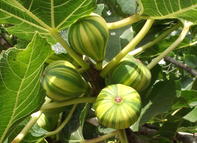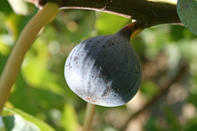Figs, one of the world’s oldest fruit, were planted in South Africa mainly for jam making and drying, but in the 2000s, fig cultivars suitable for exporting as fresh eating fruit, were planted.

Fresh figs need to a have a shelf life of about a week to allow for transporting, while figs for drying are more suitable for planting in drier regions of South Africa.
Figs varieties range from very small and almost round to large pear-shaped to almost oblong as in the case of the ‘banana fig’. Fig colours can range from almost black with dark-red flesh to yellowish green with pale pink to almost white flesh.
The names of fig cultivars can be confusing due to varieties that are known under different names in different countries. There may be as many as 700 varietal names but many are synonymous. Some of the main commercial figs are described below:
Dark-Skinned Figs

South Africa’s flagship fig variety is Parisian/Evita. It is the most widely planted variety in South Africa. The small to medium fruit has purple skin and red flesh with excellent eating quality and good shelf life.
The tiny Ronde de Bordeaux figs also known as ‘Eve’, produce cocktail-sized figs early in the season. Some plantings, 4 ha can be found in Porterville.
One of the first fig varieties planted in South Africa is the late-bearing medium-sized ‘Adam’. It has purple skin and dark-red flesh. Adam is a good eating fig and suitable for drying but does not travel well.
Similar in appearance but with a black-red skin, the ‘Black Genoa’ ripens earlier than ‘Adam’ and is considered a mid-season fig.
‘Tangiers’ is a large fig with a very good taste and shelf life. Very good for drying. This variety is planted in Piketberg, Hermon, Napier and Prince Albert.
A late-season fig with deep red flesh, ‘King’ produces small figs, which may be prone to cracking. Plantings are in Worcester, Ladismith and Oudtshoorn.
‘Black Mission’ has a purple to black skin with red flesh and an excellent ‘fig’ taste.
The ‘Cape Black’ produces small round figs with purplish-black skin with white flesh. A heavy bearer, it is a popular jam fig and is processed skin-on.
The khaki-coloured ‘Cape Brown’ is one of the oldest figs in South Africa and is easily recognisable by its long stem. It is a popular eating and jam fig.
The popular eating fig ‘Brown Turkey’ is marketed as a fresh fig and is produced in Turkey, the USA and Israel.
Light-Skinned Figs
‘Calimyrna’ is a squat, white fig with white flesh and is the most popular fig used for drying in Turkey and the USA. Due to the complexity of pollination, it is not recommended for commercial farming in South Africa.
More green, than purple, ‘Dauphine’ produces very large breba figs weighing up to 240 gm. This variety, in South Africa, is only planted in Napier in the Overberg.
The small and early-ripening ‘Cape White’ is a very old fig variety in South Africa. It has green skin and light pink flesh. It is popular for use in jams.
The green-skinned ‘Kodota’ has white to pink flesh and is very sweet fig. ‘Kodota' can be eaten and processed skin-on and is harvested early to mid-season.
The green-skinned ‘White Genoa’ is a popular fig for its substantial breba harvest and is used for jams.
Imported into South Africa by the Agricultural Research Council Infruitec, ‘Deanna’ is a prolific bearer of large yellowish green figs. It produces figs with excellent fresh-eating qualities, it has a long shelf life and is suitable for both drying and jams.
By Marinda Louw